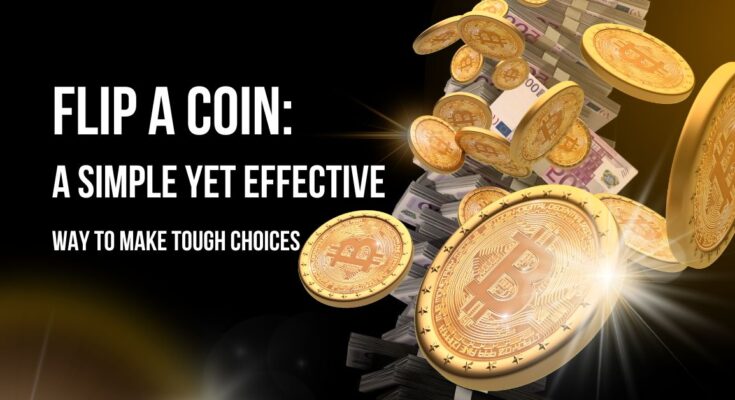Introduction to Flip a Coin
Have you ever found yourself stuck between two options, deciding which path to take? We’ve all been there. Making tough choices can be overwhelming and stressful. But what if I told you that flipping a simple coin could help you make those decisions easily? Yes, you heard it right! The age-old method of flipping a coin has proven to be an effective way to tackle dilemmas, big or small.
Let’s dive into the fascinating world of decision-making and discover how this simple trick can bring clarity when faced with uncertainty.
The Psychology Behind Decision-Making
Understanding the psychology behind decision-making can explain why we make confident choices. Our brains are wired to seek out patterns and make quick judgments based on limited information. This can lead to biases that influence our decisions without realizing them.
Emotions also play a significant role in decision-making, often clouding our judgment or pushing us toward specific options. The fear of missing out or the desire for instant gratification can sway our decisions in ways we may not fully comprehend.
Moreover, cognitive dissonance can arise when faced with conflicting choices, causing inner turmoil as we weigh the pros and cons. Our past experiences, beliefs, and values all shape how we approach decision-making processes – consciously or subconsciously.
What is the Coin Flip Method?

Have you ever found yourself torn between two options, unable to decide? The coin flip method offers a simple yet effective way to resolve indecision. Here’s how it works: when faced with a tough choice, assign each option to one side of the coin – heads for option A and tails for option B.
Give the coin a flip, and let chance decide your fate. As the coin is in the air, you might secretly root for one outcome in that split second. This method helps you make decisions and reveals your true desires.
The beauty of this method lies in its ability to provide clarity by stripping away external influences and allowing your subconscious preferences to surface. It can break through analysis paralysis and bring about quick resolutions.
Next time you’re stuck between a rock and a hard place, consider flipping a coin – it just might be the unconventional solution you need.
When to Use the Coin Flip Method
When faced with a tough decision and you find yourself going back and forth, weighing the pros and cons, it might be time to bring out the trusty old coin. Using the coin flip method can be particularly useful when you are torn between two equally appealing options or when your emotions cloud your judgment.
If you’re stuck in a situation where both choices have their merits but can’t make up your mind, flipping a coin can provide clarity. It’s like momentarily outsourcing the decision-making process to chance, temporarily allowing fate to take over.
The randomness of a coin flip can help break analysis paralysis and push you toward making a choice. Plus, seeing how you feel about the flip’s result can reveal what your heart truly desires – whether it agrees with the outcome.
So next time you find yourself stuck in indecision, consider trying the coin flip method—it may lead you down the path that feels right for you.
Pros and Cons of Using a Coin Flip
There are advantages and disadvantages when using a coin-flip method for decision-making.
Conversely, flipping a coin can clarify when you feel stuck or overwhelmed. It takes the pressure off you and leaves the outcome to chance, which can be liberating.
Moreover, the coin flip method is quick and straightforward. It doesn’t require overthinking or analysis paralysis; you choose based on how the coin lands.
However, relying solely on a coin toss may only sometimes lead to the best decision. Some argue that important choices should involve more thought and consideration rather than leaving them up to luck.
Additionally, there’s always the possibility of regret if you disagree with what the coin decides. In such cases, it’s essential to reflect on whether flipping a coin was truly helpful in making your decision.
Real-Life Examples of Successful Coin Flips
Have you ever heard of the story where a successful entrepreneur had to decide between two lucrative business opportunities? Unable to choose, he flipped a coin. The result led him down an unexpected path that ultimately resulted in tremendous success.
In another instance, a couple was torn between two dream wedding venues. After countless debates and indecision, they finally resorted to flipping a coin. The chosen venue was even more magical than they could have imagined.
A famous actor once used the coin-flip method to decide whether to take on a challenging role. Trusting the outcome of the toss, he embraced the opportunity and received critical acclaim for his performance.
These real-life examples demonstrate how sometimes leaving decisions up to chance can lead us in surprising and rewarding directions. It’s not about luck but rather about embracing uncertainty and being open to new possibilities that may arise from a simple flip of a coin.
Alternatives to the Coin Flip Method
Regarding decision-making, the coin flip method is one of many tools in your toolbox. There are other alternatives you can consider when faced with tough choices.
One alternative is the list of pros and cons. By weighing the advantages and disadvantages of each option, you can make a more informed decision based on logic rather than chance.
Another approach is seeking advice from trusted friends or family members. Sometimes, an outsider’s perspective can offer valuable insights that sway your decision one way or another.
You could also try visualizing different scenarios and outcomes before making a choice. This technique allows you to mentally explore the potential consequences of each option without leaving it up to fate.
You can use various methods to aid your decision-making process beyond simply flipping a coin. Each alternative offers unique benefits and drawbacks, so choose wisely based on your preferences and circumstances.
Conclusion: Trust Your Gut or Leave it to Chance?
There is no one-size-fits-all approach When it comes to making tough decisions. Both trusting your gut and leaving it to chance have merits and drawbacks. The key is understanding your situation, weighing available options, and choosing the best method with your instincts and values.
Whether you trust your gut or leave it to chance with a simple coin flip, what matters most is confidence in your decision-making process. Trust yourself to make the right choice for you at that moment. After all, life is full of uncertainties, but how we navigate through them defines our journey. So take that leap of faith, or let fate decide – remember that every decision shapes your path forward.




